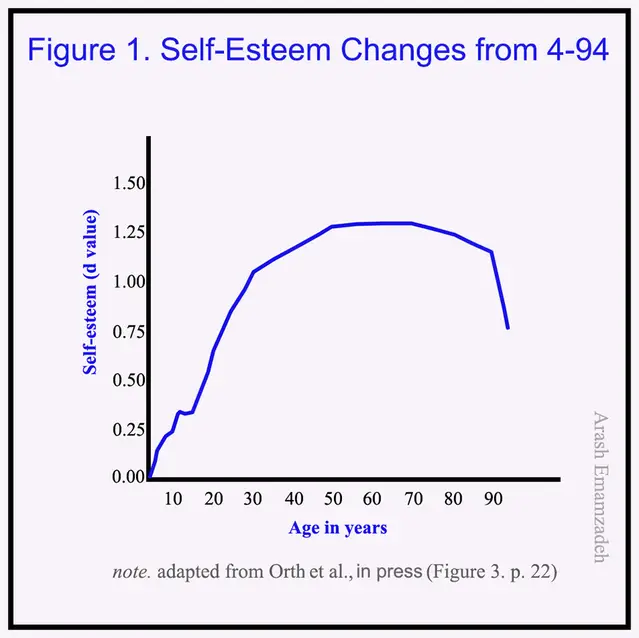Self-esteem is not static and it can vary greatly with age. In this article, we will discuss which age ranges experience the lowest levels of self-esteem and look at the reasons why.
The lowest self-esteem appears in the very young and old. According to Orth et al., self-esteem is lowest at birth and increases sharply until the age of 30. After approximately 70 years old it drops again and falls sharply after about 90 years of age to the same level as that of a 25-year-old.
So, we have our answer, the lowest self-esteem levels are in young children and the elderly. But why is this so, and how does this help us to understand the nature of self-esteem? Let’s look into these numbers in more detail in order to discover what they can teach us.
Why 0-15-year-olds have the lowest self-esteem
From the age when we are born our self-esteem grows according to the research. Why you might ask?
When we are born there are so many things we see others doing that we can’t do. Talking, walking and eating are some examples. A young child depends on others, so it’s not surprising that as a child grows and becomes able to look after itself and master the life skills we all need for survival, this newfound independence translates into a growth in self-esteem. This growth may be interrupted during the huge changes in life that a young teenager experiences.
What we can learn from this is that self-esteem does seem to depend on our level of independence and can be boosted by achievement. Therefore, one way of building self-esteem is to focus on achieving more and developing a sense that these achievements are enabling us to be more reliant on ourselves and less dependent on others.
Another aspect that affects our self-esteem is the control or lack of it that we feel we have over our life choices. As young people, we understand that our freedom to choose is limited and our parents are the ones who make most of the decisions for us. This removes our sense of control to be who we want to be. This is especially hard for a teenager to accept, as teenagers believe they should be more independent. This can put them in potential conflict with their parents and family.
Often, this can be a time of great challenge and conflict in life and many teenagers can suffer from the consequences of low self-esteem because of the way they feel about themselves.
How age affects self-esteem
Continuing on from the above, life experience usually leads to a general rise in self-esteem as we successfully overcome the challenges we face. We also experience increasing independence, especially after the age of 18 or so when many people leave home to study or work. As we earn our own money and complete our education we feel better about our growing independence. This is a time of growing self-esteem as every step we take seems to move us toward exciting new phases of life.
The growth in self-esteem is most apparent during periods in life when we experience the greatest change. This is in young adolescence, teenage and early 20s. The graphs we see depicting the variation of self-esteem with age seem to agree perfectly with this idea.

Old age is another period when change occurs rapidly and this appears to be a reversal of independence as we become more and more dependent on others with increasing age. It seems inevitable that as we get much older and lose our independence our level of self-esteem drops. We’ll come to look at this in more detail below.
Why does self-esteem increase so much in the early years?
The most rapid increase in self-esteem occurs from birth, when a child is most helpless and dependent on others, until about 10 years of age. This period is full of learning from the most basic skills of life to subtler ones that come later as a child needs to communicate and socialize.
Not only is this period a time of intense learning, but it is also a time of self-discovery and search for identity in a world which seems strange to us and very threatening. Each time a young child learns something that enables another step towards independence, self-esteem and confidence grows.
Discovering more about the world and our place within it gives us even more confidence-boosting knowledge of who we are. As we begin to develop a sense of identity as unique people more in control of our lives, self-esteem increases at a healthy rate. This is the general pattern but for some unlucky children, events in life can reverse this natural development in self-esteem and serious issues can happen which may affect a person’s future.
A large part of our self-esteem acquired as young children, therefore, comes from our experience of life as well as our relationships with parents and other important people in our lives. We need to trust those who know more than us and believe in those that help us grow. If that trust is betrayed, long-lasting damage can affect a child and continue into adulthood. Abuse is a horrible example of this.
Thankfully the vast majority of young children have a supportive family and loving parents who devote themselves to helping and guiding young children to learn and explore the world and discover more about who they are. The positive effect of such a good upbringing results in a steady growth of self-esteem.
Why does self-esteem drop so rapidly in the older age groups?
This could be viewed as a reversal of what happens during childhood when a child learns and adapts to the world and its rules. Each time a child successfully overcomes the hurdles and develops skills, he or she feels more independent and capable. This is reinforced by parents and others who notice and remark on the child’s progress.
In old age, this works in reverse. The elderly tend to feel more left out and isolated as the years go by. They can feel less able to contribute to society as they can no longer work or look after themselves without support. Consequently, as opportunities to socialize or travel appear to become more limited, they may feel less valued by others and will in turn start being more negative about life in general and their role in it.
In older age, a person may start to have problems walking, dressing, and doing all kinds of things they used to do and this affects how they see themselves. Independence gradually reduces to the point where the very old may need full-time care. It is easy to understand that the shock of accepting this phase of life and its limitations may cause a drop in levels of self-esteem.
Final Thoughts
The fact that at either end of the age spectrum self-esteem appears to change rapidly, increasing in young children and adolescents whilst falling in the elderly, seems to confirm that both a sense of achievement and recognition are significant factors in our level of self-esteem. This is very helpful to know because it can enable us to help others or ourselves and maintain healthy self-esteem. If we can build self-esteem we can live much more productive and happy lives. By feeling better about ourselves we are also more likely to be able to have positive self-esteem. A higher level of self-esteem can change lives for the better, so it is an aim worth working for!

